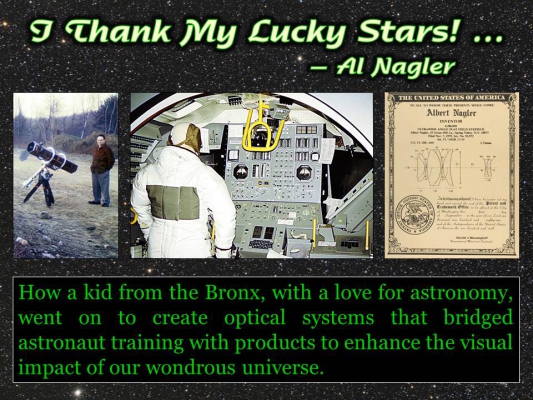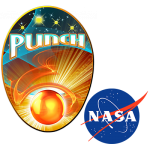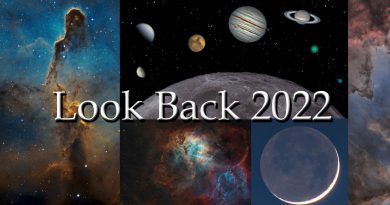2021: A Year of Ups and Downs
Welcome to 2022! In this posting, we’ll examine how the pandemic impacted amateur astronomy this past year and review our most popular social media posts from 2021.

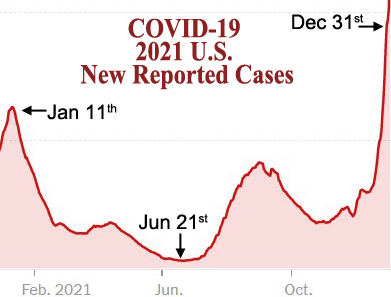
2021 U.S. COVID-19 New Reported Cases (7-day average). The early-summer dip, centered on June 21st, did not last very long. Adopted from New York Times “Coronavirus in the U.S.: Latest Map and Case Count“.
As 2021 progressed, there were hopes that star parties and astronomy shows would return in full force as COVID-19 showed signs of being contained. Statistical data from early-summer 2021 heralded the good news: new virus cases had dropped dramatically to only 1/20th that of the January peak (graph at right). Mask and social distancing signs came down in anticipation of a return to “normal.” However, like a raging wildfire, the virus mutated and broke containment through the summer and fall and new cases reached and surpassed all prior peaks.
Virtual Star Parties
So, in many ways, 2021 was a “re-run” of 2020: safety concerns led to the cancellation of many star parties and events. Casualties included the likes of the Texas Star Party, Cherry Springs Star Party, Golden State Star Party, Northeast Astro-Imaging Conference, and down the line.
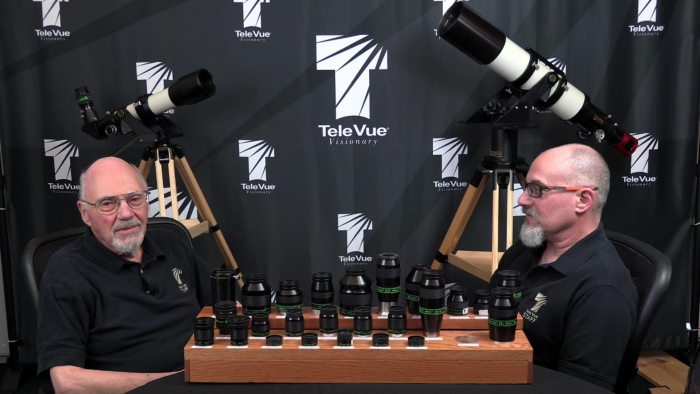
But, some events went virtual, such as the Northeast Astronomy Forum (NEAF). As our video contribution to April’s Virtual NEAF 2021, we asked our social media audience to send us their Tele Vue product questions to be answered by David and Al Nagler. Our early April blog post, Virtual NEAF 2021: Your Questions Answered!, published a few days before the event, ended up as a top-10 post for the year. It contained a 1-minute, “sneak peek” compilation of our video contribution. Our follow-up blog, Our Virtual NEAF 2021 Videos, contains links to all seven videos we produced in our “virtual NEAF booth.” The videos are a great supplement to the product information on our TeleVue.com website (mobile site). We answered questions about quality controls, near IR performance, replacing a Dobsonian with a small scope, and the feasibility of introducing faster Nagler-Petzval refractors, and Ethos eyepieces with wider fields.
The yearly Winter Star Party was also a virtual, multi-night, event in February 2021. Al Nagler led off the third night with his I Thank My Lucky Stars presentation.
Sheltering in Space
“Sheltering in space” is a phrase we came across with the first pandemic lock-downs in March 2020. It was in a Flickr caption, under the image of the Christmas Tree Nebula made with our Tele Vue-85 APO refractor by Los Angeles-based amateur Bill Allen. With other types of activities curtailed by the virus, interest in amateur astronomy exploded and two years later, many continue to follow Bill’s lead.
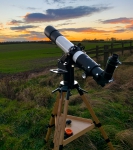
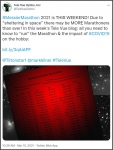
Amateur astronomers need to prepare for celestial events, so it is no surprise that our early January, Your 2021 Sky Event Planner, post easily made our top-10 blog posts (by page views) for the year. Another event-based post, July’s The Giants at Opposition!, detailing the opposition circumstances of the gas (Jupiter and Saturn) and ice (Uranus and Neptune) giant planets in the second half of the year was our most viewed blog post for 2021. Another observational event, the 2021 Messier Marathon, was the subject of our top tweet for the year, with 3,145 impressions.
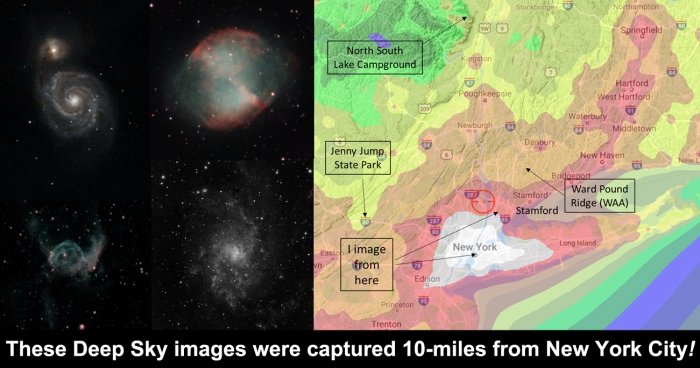
Imaging blog posts did well this year. February’s Tele Vue-85: Imaging Under New York City Light Dome! (including discussion of Bortle scale and Sky Quality Meter) was the 4th most popular blog post overall and the top imaging blog post. In the blog rankings, this was followed by January’s Tele Vue-76: Imaging New Mexico Skies! in 5th place and May’s NP101: Imaging the Skies Over Colorado & New Product! as the 6th most viewed blog post.
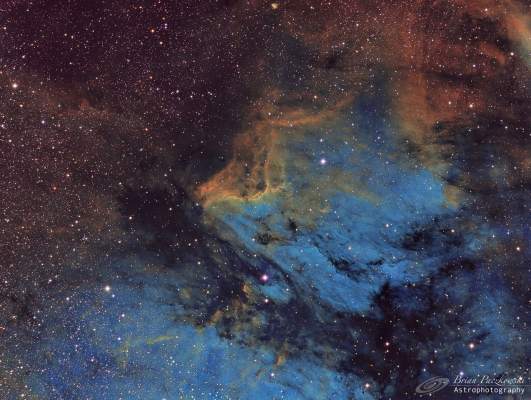
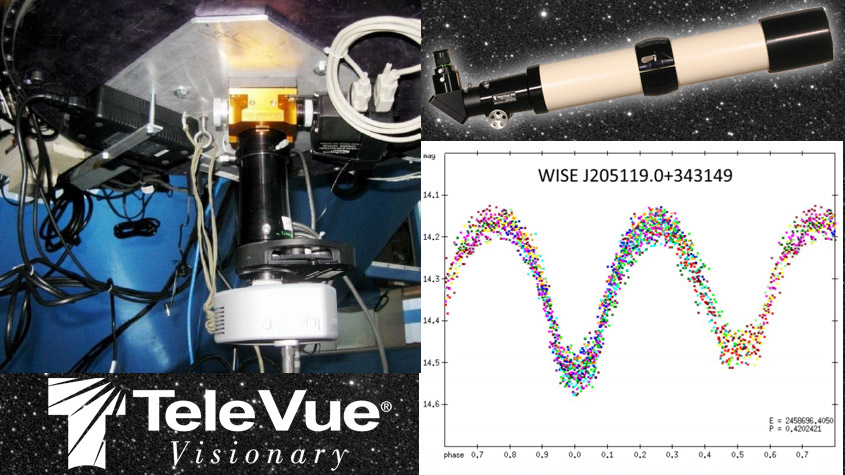
Contributing to Science
Tele Vue’s reputation for product quality attracts the interest of professional astronomers looking for “off-the-shelf” solutions for their experimental needs. This was the inspiration behind our second most popular blog post of 2021: Tele Vue Scientific Part 3+ New Product Announcement! from August. This was the final entry of a multi-part series looking at published science papers that acquired data using Tele Vue gear. In this edition, we discussed the addition of our 4x Powermate to Kitt Peak’s 2.1-meter Ritchey–Chrétien for speckle imaging and learned how a Tele Vue refractor was refining the light curves of eclipsing binary stars. We also announced our M54 Camera Adapter for Tele Vue Imaging System.

In Tele Vue Scientific Part 1 we examined the use of a Tele Vue-NP101 for detecting exoplanets from Antarctica (where the seeing resolves all the way down to 1.3-arcseconds!) and discussed our work on the Polarimeter to UNify the Corona and Heliosphere (PUNCH) microsatellite mission.
“Sneaky” teleduplication of house keys, using a telescope equipped with our Powermate amplifier, as well as re-creating the eclipse experiment that made Einstein famous was covered in Tele Vue Scientific Part 2.
In September of 2021, amateur astrophotographer José Luis Pereira (São Paulo, Brazil) got worldwide attention for capturing a rare impact on Jupiter using a Newtonian (275mm f/5.3) with our Tele Vue 5x Powermate (7.2-meter effective focal length). We’ve used his planetary images on our blog in the past, with the same scope setup as the Jupiter impact images.

It was the 10th recorded impact on Jupiter since interest in the topic was kicked off by comet Shoemaker-Levy 9 crashing into Jupiter in 1994.
In July, a NASA Night Sky Network webinar included Tele Vue’s contribution to the upcoming PUNCH (Polarimeter to Unify the Corona and Heliosphere) multi-satellite mission to study the Sun’s outer atmosphere. Tele Vue is supplying the optical lens assembly for the Wide Field Imager cameras that will image the solar wind as it leaves the corona (outermost layer of the Sun’s atmosphere). Stay tuned to this blog for updates. The launch date is in 2023.
Tele Vue Products
Our March Tele Vue Product Anniversaries! blog post ranked 9th for the year. With continual improvements, some of our products have been in production for decades. Solid engineering means we don’t have to continually introduce new products to stay competitive. We also discussed the origin story of several products.
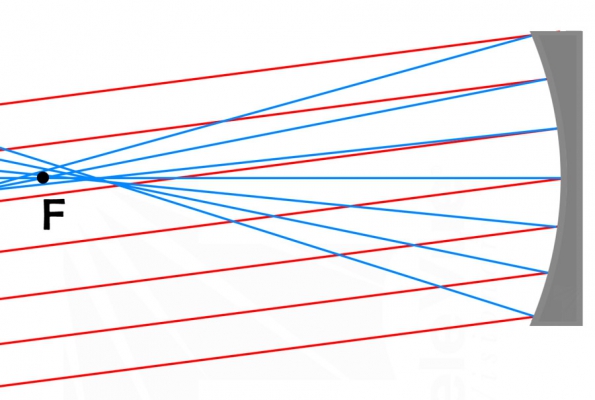
Our two-part “Paracorr-Newtonian for Visual and Imaging” blog exposition took our readers on a trip through the evolution of the Newtonian telescope. From Newton’s 17th century, spherical metal-mirror, table-top curiosity, to the mid-19th century metal-coated glass parabolic mirrors that made reflectors practical, to the 20th-century explosion of Dobsonian scopes, we land in the 21st century’s “new Dobsonian Revolution” world of big and fast scopes. We discussed how Tele Vue’s Paracorr played a role in the evolution of the humble Newtonian scope by explaining how Paracorr enlarges the “sweet spot” of fast reflectors to cover the entire field. We also consider how well the expensive “exotic” scopes on the market perform against a lower-priced, fast Newtonian with Paracorr Type-2 installed. Also, did you know there are three types of Paracorr? We weigh the pros and cons of each. June’s Paracorr-Newtonian for Visual and Imaging to f/3! Part 1 was our 3rd most-read blog post of 2021 and July’s Paracorr-Newtonian for Visual and Imaging to f/3! Part 2 was the 8th most read post.

Social Media Milestones
We reached some social media milestones this year: on Instagram we passed 2,000 followers in March, followed by our Twitter feed passing 1,000 followers in May, and our blog mailing list passed 2,000 subscribers in December.
Throughout these years of the pandemic, we’ve all hoped that next year would be better. But, we just heard that the week-long Winter Star Party (Jan 31st – Feb 6th) in the Florida Keys has been canceled. It, unfortunately, looks like 2022 is starting out as 2021 ended. Other star parties and events are optimistically accepting registrants. So, let’s continue to prepare for the worst hope for the best.
Tele Vue wishes you a happy and healthy New Year!
Did you observe, sketch, or image with Tele Vue gear? We’ll like your social media post on that if you tag it #televue and the gear used. Example:
televue #tv85 #ethos #jupiter
Do you want your Tele Vue images re-posted on Tele Vue Optics’ Social Media accounts? Use this hashtag for consideration:
#RPTVO

